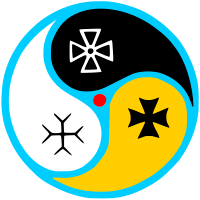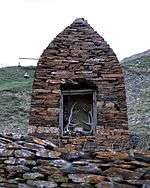Uatsdin



Uatsdin (Ossetian: Уацдин), otherwise spelled Watsdin, also known as Assdin (Ассдин, "Ese-Faith"), or by the extended name Ætsæg Din (Æцæг Дин, literally "True Faith"; the same meaning of "Uatsdin", which is a word compound),[1] and among Russians as Assianism (Russian: Ассианство, Assianstvo; alternative rendition of "Assdin"), is the modern neo-Pagan movement and religious organization of the same name founded in North Ossetia.[2] It's followers consist primarily by the Ossetians (an Eastern Iranic, Alan-Samatian ethnic group inhabiting a homeland in the Caucasus that is split nowadays between two states: the Republic of North Ossetia–Alania within Russia, and the neighbouring state of South Ossetia). This religion has experienced an organised revival since the 1980s.[3]
In the Ossetian case, certain traditions of folk religion had survived with unbroken continuity, and were revived in rural areas. This contrasts, and interacts, with an urban and more intellectual movement which elaborated a systematic revival religion to overcome the crisis of identity of the Ossetian people, based in ethnic nationalism and opposition to both Russian and Georgian Orthodox Christianity, perceived as foreign, and opposed as well to the Islam professed by the neighboring Turkic and Caucasian ethnic groups and among a small minority of Ossetians.[3] The major organisation among Ossetians is the Atsætæ organization (Ossetian: Ацæтæ; Russian: Асата, Asata) led by Daurbek Makeyev, based in North Ossetia–Alania.
The Uatsdin movement is active both in North and South Ossetia. Whilst there are no figures about religious demographics for South Ossetia, in North Ossetia–Alania about 29% of the population was practicing this ethnic folk-religion in 2012, according to a survey carried out in that year.[4]
Etymology
Ætsæg literally means "right", "true" in the Ossetian language, and is a cognate of Avestan haiθiia, also meaning "true". Din is a cognate of the Avestan daena (whence din in Persian), which represents "insight" and "revelation", and from this "observance" and "religion", but also "consciousness".
Theology
Uatsdin contemplates the worship of a supreme God, Xwytsau (Хуыцау), meaning "Heaven" or "Sky", who is the creator of the universe and of all beings. The supreme God may be called upon by a multiplicity of epithets, including simply "Yštyr Xwytsau" (Ыштыр Хуыцау), meaning "Great Heaven", but also "Duneskænæg" (Дунескæнæг), "Creator of the Universe", "Meskænæg Xwytsau" (Мескаенаег Хуыцау) and "Styr Xwytsau" (Стыр Хуыцау), meaning "God of the Gods". Uatsdin's theology affirms that God is within every creature, and in men he manifests as consciousness and worthy action.[5] A variety of other beings, lesser gods, ancestors and heroes such as Uastyrdzhi, are worshipped as intermediaries with Xwytsau.[6]
State recognition
There are attempts to turn local traditional gods into objects of national worship in North Ossetia–Alania. For example, in former times, a grove was devoted to the local communal god/saint Khetag. After the clashes between Ossetians and Georgians in 1991–1992, a glade near the wood was turned into a place for pan-Ossetian worship, including religious and political rituals, with activities supervised by the Great Council of Ossetian Priests (Styr-nykhas), a non-governmental committee established in 1993.[7]
The Khetag celebration was approved by the 1990s president of North Ossetia–Alania as a national holiday. A special foundation was established in order to raise funds for the reconstruction of the site, and since 1994 a big annual sacrifice is arranged at the Khetag shrine.[7]
In 2009, at the Center for Conservative Research of Moscow State University, led by philosopher Alexander Dugin, a conference was held about the role of Ossetians in Russian history. Among participants there was, among others, Daurbek Makeyev, the head of the Atsætæ Church. On that occasion, Dugin praised the revitalisation of Ossetian culture for it having preserved a pristine Indo-European heritage. He discussed the importance of Scythian culture in the development of broader Eurasia, recognising that Scythian culture had an enormous impact on the development of Finno-Ugric, Turkic and Slavic cultures, and despite this European scholars have paid little attention to it so far. Makeyev declared that the Atsætæ Church was founded for fostering traditional Ossetian religion, but also to share the heritage of Assianism with other peoples, because "what was preserved in Ossetia is not [merely] Ossetian, but is a worldwide heritage".[8]
See also
References
- ↑ Местная религиозная организация традиционных верований осетин «Æцæг Дин»
- ↑ http://www.iriston.com/nogbon/news.php?newsid=427
- 1 2 V. A. Schnirelmann. "“Christians! Go home”: A Revival of Neo-Paganism between the Baltic Sea and Transcaucasia". Journal of Contemporary Religion, Vol. 17, No. 2, 2002. See profile at Taylor Francis Online; doi:10.1080/13537900220125181. "Since the turn of the 1980s, a growth of Neo-Paganism has been observed in the Middle Volga region, in North Ossetia-Alaniia, and in Abkhazia. Pagan traditions had never disappeared there completely and, in contrast to the Slavic and Baltic regions, there was no need to invent too much by reference to books, as almost all the resources were intact there. Thus, in these regions, interest in Paganism developed in two different environments: firstly, in the countryside with its unbroken continuity of traditional folk beliefs, and secondly, in the urbanized areas where local, highly secularized intellectuals began to construct a new synthetic religion in order to overcome a crisis of identity. In the latter case, this was a manifestation of local ethnic nationalism resisting Russian Orthodoxy as a "religion of exploiters" (Filatov & Shipkov, 1996)." (p. 202). "Contemporary Neo-Paganism is constituted by two different branches—one of a "bookish" approach which is artificially cultivated by urbanized intellectuals who have lost their links with folk tradition, and the other, more authentic, is of a rural movement based on a continuity rooted in the remote past. The first dominates among the Russians, Ukrainians, Belorussians, Lithuanians, Latvians, and Armenians and can be defined as an "invention of tradition", after Eric Hobsbawm (1983). A more complex pattern can be observed among the ethnic groups of the Middle Volga River region as well as among the Ossetians and Abkhazians, where both tendencies are interacting with one another." (p. 207)
- ↑ Arena - Atlas of Religions and Nationalities in Russia. Sreda.org; 29% "adhere to a traditional religion of their ancestors, worship gods and the forces of nature". (исповедую традиционную религию своих предковпоклоняюсь богам и силам природы). This figure compares to 1.2% adherents of ethnic religions in all of the Russian Federation.
- ↑ Schmitz (2015), p. 1.
- ↑ Schmitz (2015), p. 2.
- 1 2 Schnirelmann (2002) pp. 204-205, citing Popov (1995, pp. 62-67) and Dzeranov (1996).
- ↑ "Александр Дугин: Осетинский народ сделал возможным возвращение России на имперскую орбиту (Alexander Dugin: The Ossetian people made it possible for Russia to return to the imperial orbit)". iratta.com. 7 October 2009. Archived from the original on 26 April 2017.
Bibliography
- Dzeranov, T. E. Vliianie gosudarstvennykh form religii na dukhovnuiu kul’turu osetin i prichiny sokhraneniia yazycheskikh verovanii v Osetii. Paper presented at the Meeting of the Scientic Board of the Russian Museums on Problemy etnokul’turnoi istorii regiona i ikh muzeinaia interpretatsiia in Stavropol’, 27–31 May 1996.
- Popov, K. P. Sviashchennaia roshcha Khetaga. Vladikavkaz: Ir, 1995.
- Filatov, S. & Shchipkov, A. Povolzhskie narody v poiskakh natsional’noi very. In Filatov, S. B., ed. Religiia i prava cheloveka: Na puti k svobode sovesti. Moscow: Nauka, 1996: 256–284.
- Schmitz, Timo. "Etseg Din – Caucasian paganism from Ossetia". 2015.
- Schnirelmann, Victor. "“Christians! Go home”: A Revival of Neo-Paganism between the Baltic Sea and Transcaucasia". Journal of Contemporary Religion, Vol. 17, No. 2, 2002. See profile at Taylor Francis Online; doi:10.1080/13537900220125181.
- Shtyrkov, Sergey. Religious nationalism in contemporary Russia: the case of the Ossetian ethnic religious project // Understanding Russianness (Routledge Advances in Sociology). Ed. by Risto Alapuro, Arto Mustajoki, Pekka Pesonen. London: Routledge. 2011. pp. 232-244.
External links
- Atsætæ Church
- "Assianism the True Faith" --- Assianstvo Wacdin -- Russian website